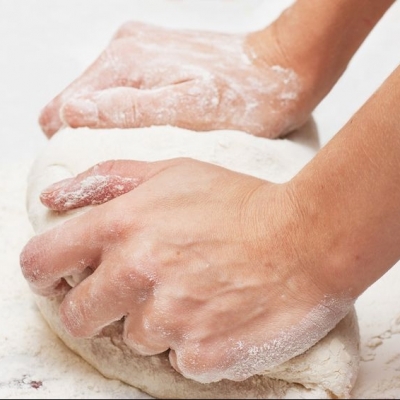
Kneading
What is Kneading?
Kneading is the process of working a dough mixture to form a smooth and cohesive mass. It can be done by hand or mechanically. Proper kneading is essential for the formation of dough with adequate viscoelastic properties including:
- Gas retention capacity
- Breads with fine grain, texture and crumb.1
Origin
It can be said that kneading is as old as the baking process itself. The dough cannot attain good functional properties unless the required ingredients are brought together and the resulting lumpy mass kneaded to form a uniform dough that is suitable for breadmaking.
How does it work?
There are two ways to knead bread dough:
- Hand Kneading: Takes 10–30 minutes to reach the optimal gluten matrix by repeatedly folding and stretching the dough. Dusting flour can be added to keep the dough from sticking, however, adding too much will dry out the dough and make it stiff.
- Mechanical Kneading: Takes 8-12 minutes and is the most efficient way to knead flour doughs. It uses a mixer/hook attachment set at a proper speed (rpm). Adequacy of kneading is determined using traditional gluten film test.
Kneading is the third of the five main stages of dough mixing. In the baking industry, mixing refers to a series of stages that are responsible for transforming flour into dough, including:1,2,3
- Ingredient incorporation: Mixing of wheat flour and water, along with yeast, salt, sugar and other ingredients.
- Hydration of dry ingredients: Water absorption by the flour’s functional components (proteins, starch, pentosans) leads to gluten development and subsequent plasticization.
- Kneading: Development of gluten strands that gradually form the protein structure or matrix due to gliadin and glutenins binding together.
- Dough aeration: Incorporation of air into the dough in the form of gas bubbles and subdivision of existing air cells.
- Dough temperature: During mechanical kneading, significant friction between dough and bowl occurs leading to slight warming up the dough.
Application
Dough development into a smooth mass is highly dependent on kneading mode and its duration. By applying a combination of strain, shear and compression, a proper balance in dough properties such as tenacity, elasticity, extensibility and stickiness can be achieved.1,2,3
- Extensibility: Ability of dough to be stretched as the gas pressure from yeast fermentation builds up. Optimal dough should have good extensibility and minimal elasticity. An extensible dough is one that can be pulled into different shapes.
- Elasticity: Ability of dough to spring back when it is stretched. This refers to the degree to which a dough piece will attempt to regain its original shape after any deforming force has been removed.
- Tenacity (strength): Ability of dough to resist stretching or elongation forces. A dough with too much tenacity is difficult to machine during moulding and will not expand as much during proofing.
- Stickiness: Ability of dough to stick to surfaces. This property is often undesirable since it is responsible for makeup issues, and may require more dusting flour when hydration levels cannot be reduced due to process economics.
Typically, doughs made with whole wheat flours require less kneading due to their low gluten content.
Quality issues related to under-kneading and over-kneading:1,2,3
| Under-kneading | Over-kneading |
|
|
References
- Haegens, N. “Mixing, Dough Making, and Dough Make-up.” Bakery Products Science and Technology, 2nd edition, Woodhead Publishing Limited, 2006, pp. 310–320.
- Figoni, P. “Gluten.” How Baking Works: Exploring the Fundamentals of Baking Science, 3rd edition, John Wiley & Sons, Inc., 2011, pp. 136–151.
- Cauvain, S.P., and Young, L.S. “The Basic Principles of Breadmaking.” The Chorleywood Bread Process, Woodhead Publishing Limited, 2006, pp. 1–5.

